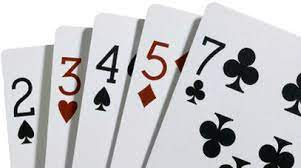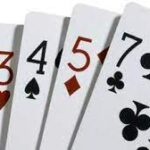In last week’s analysis, we found that the series of numbers 1-4-10-20-35-76 were extremely important when it comes to figuring out the number of starting hand combinations for pat hands. As we’re going to see this week, it’s also useful for finding the possible starting combinations for four-card drawing hands. However, it’s also going to depend on which cards you would discard to draw in the first place.
Understanding the Possible Draws: The Drawing Factor
Suppose we are going to be drawing with a hand like X7432 which is an extremely strong hand. We need to know which cards could fall in place for the X. We would obviously discard an A, K or Q in most situations, though we might also discard a J or even a T in others. The drawing factor is a measurement of how many different ways we could actually be dealt a specific draw based on how many different cards could show up in place of X.
There are four instances of each of these cards, so if we were going to discard just an A, K or Q, then we could describe it as being three different cards based on rank or 12 different cards based on distinct cards. For our purposes so far in this series, we are just worried about the different cards, so discarding a Q or higher would mean we’re discarding 3 ways.
However, you also have to take into account the pairs we could have. For example, there are three each of 7s, 4s, 3s and 2s that could be the X in that hand above. You’ll notice that this is 12 distinct cards which is the same number of combos as if we had just A, K and Q since those cards aren’t pairing out hand.
So for our purposes, when asking how many cards we want to discard, we are going to start with 3 to compensate for the paired combos and add one for each of Ace, King, Queen, Jack, etc. that we would have.
So as an example, if we were discarding an Ace, King, Queen and Jack, we’re going to call that a drawing factor of seven. Along these lines, if we were only discarding an Ace, King and Queen, then the drawing factor would be six. You have to know your drawing factor before you can count draw combinations, so this is always the first step.
Getting Into the Combinations
How many ways can you have a four-card draw with a specific high card? For example, how many ways can you have a 7xxx draw? There are actually ten ways: 7432, 7532, 7542, 7543, 7632, 7642, 7643, 7652, 7653 and 7654. The series of numbers 1-4-10-20-35-76, the sums of the triangular numbers that we looked at last week, can answer this question for you.
How many ways to be dealt a draw for 5xxx? Just 1.
What about 6xxx? Exactly 4.
We just said the answer for 7xxx: 10.
For 8xxx it’s 20, for 9xxx it’s 35, and for Txxx it’s 76.
Multiply the number of ways to be given a specific four-card draw with the 1-4-10-20-35-76 shortcut by the drawing factor we discussed above, and you have the number of combinations for the draw. This is a little complicated, so we’re going to look at a few examples.
Example Calculations of Drawing Hand Combinations
Example 1: How many combinations of 5xxx, 6xxx, 7xxx or 8xxx are there if we are discarding an Ace, King, Queen or Jack?
We always start with the drawing factor. Since there are four high cards we’re discarding, we add three to get a drawing factor of 7.
Now we need to know the number of draw hands we’re dealing with. For the 5xxx hands it’s 1, for the 6xxx hands it’s 4, for the 7xxx hands it’s 10, and for the 8xxx hands it’s 20. We can add all of those together to see that we’re dealing with 35 different drawing hands.
If we multiply the number of drawing hands (35) by the drawing factor (7), then we get the number of starting hand combinations for these draws: 245.
Example 2: How many combinations of 5xxx, 6xxx, 7xxx, 8xxx or 9xxx can we have if we’re discarding an Ace, King or Queen only?
Step one: drawing factor. We’re discarding three high cards, so add three to get a drawing factor of 6.
Step two: how many drawing hands are we working with. Going from 5xxx to 9xxx means we need to add 1 + 4 + 10 + 20 + 35 which gives us 70.
Multiply those together to get a total of 420 combinations.
The Strict Definition of Combinations
What we’ve called combinations in this week’s column aren’t strictly combinations. Instead, they’re just specific ways to be dealt hands. There are actually 1,024 different combinations for each one of these individual hands, but they all have essentially the same value except the four that are suited which is such a small percentage of hands that we’re ignoring them for now.
This method will match up for the different ways that you can be dealt pat hands that we looked at last week. If you start looking at specific examples, you’re going to find that there are a ton more different ways to be dealt one-card draws than pat hands in no-limit 2-7 single draw.
Next week, we’re going to look at how to combine these calculations to look at different ways to quantify ranges pre-flop so that you can start answering questions like “What are the top 10 percent of hands?” This is going to be a little tricky since you’ll need to know this week’s work and last week’s work, but it’s not that bad since all of the math involved to do the calculations is very minor.
Learn More
No-Limit 2-7 Single Draw Strategy (Part 1): The Basics
No-Limit 2-7 Single Draw Strategy (Part 2): Pat Hand Combinations
No-Limit 2-7 Single Draw Strategy (Part 3): Draw Combos
No Limit 2-7 Single Draw Strategy (Part 4): Pre-Draw Overview
No-Limit 2-7 Single Draw Strategy (Part 5): Post-Draw With Draws
Submit your review | |







